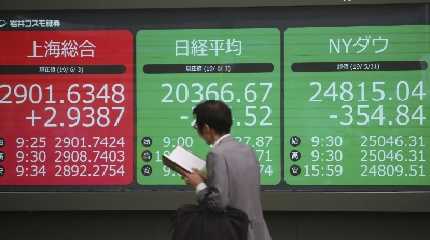
BANGKOK (AP) — Share prices tumbled in China on Tuesday, with Hong Kong’s Hang Seng index down nearly 6% and the Shanghai Composite index sinking 5% as virus lockdowns and rising numbers of COVID cases threaten to disrupt manufacturing and trade.
The sell-off gathered pace late in the session despite the release of data showing strong increases in retail sales, industrial production and investment in January-February. It followed the Chinese central bank’s decision not to ease interest rates to spur economic growth.
Stocks also fell elsewhere in Asia and oil prices slid further as Russian forces pounded the Ukraine capital ahead of another round of talks between the two sides.
Anxiety over the war in Ukraine and an upcoming Federal Reserve meeting on interest rates are keeping markets on edge.
Uncertainty about whether persistently high inflation might stifle the global recovery from the pandemic has caused gyrations in prices for oil, wheat and other commodities produced in the region, bringing day-to-day and hour-to-hour reversals across markets.
“Markets appear to have been trafficking in an odd mix of hope, fear and uncertainty,” Mizuho Bank said in a commentary.
Shares in Hong Kong have sunk to near six-year lows after the neighboring city of Shenzhen was ordered into a shutdown to combat China’s worst COVID-19 outbreak in two years.
The Hang Seng index lost 5.9% to 18,376.60 after wobbling more than 6% lower. The Shanghai Composite gave up 5% to 3,063.97.
“Fears continue to dog stock markets that lockdowns could spread, which would severely impact China’s growth,” Jeffrey Halley of Oanda said in a commentary.
Tokyo’s Nikkei 225 rose 0.2% to 25,346.48, while the Kospi in Seoul gave up 0.9% to 2,621.53. Australia’s S&P/ASX 200 slid 0.7% to 7,097.40 and shares also fell in Taiwan and Bangkok.
Oil prices have tumbled this week, taking some pressure off the inflation sweeping the globe, with a barrel of U.S. crude falling below $100 per barrel after touching $130 last week.
U.S. crude shed $5.04 to $97.97 per barrel in electronic trading on the New York Mercantile Exchange. It tumbled $6.32 to $103.01 on Monday.
Brent crude, the standard for pricing international oils, gave up $5.43 to $101.47 per barrel.
In other developments, the London Metal Exchange said trading in nickel will resume Wednesday, just a week after it was suspended when the price of the metal skyrocketed to over $100,000 per ton.
The announcement followed a notice from Tsingshan Holding Group, a Chinese metals giant, that it had struck a deal with its creditors on a “standstill arrangement” such that the banks would not make margin calls or close out their positions against it while the company is resolving its nickel margin and settlement requirements.
Russia is the world’s No. 3 producer of nickel. It’s price and that of many other commodities has surged on speculation over possible disruptions to supplies as Russia contends with widening economic sanctions following its invasion of Ukraine.
On Monday, negotiators from Russia and Ukraine met over video conference for a new round of talks that ended without a breakthrough after several hours as negotiators took “a technical pause,” Ukrainian presidential aide Mykhailo Podolyak said. They planned to meet again Tuesday.
Investors were already uneasy before the war began because central banks around the world are preparing to shut off the stimulus they pumped into the global economy after the pandemic struck.
The wide expectation is that the Federal Reserve will raise its key short-term interest rate by a quarter of a percentage point on Wednesday. It would be the first increase since 2018, and it would pull the federal funds rate off its record low of nearly zero.
On Monday, the S&P 500 gave up an early gain and closed 0.7% lower while the Dow Jones Industrial Average was essentially unchanged. The Nasdaq fell 2% and the Russell 2000 index slid 1.9%.
The pullback came as the yield on the 10-year Treasury touched its highest level since the summer of 2019. It was at 2.11% Tuesday, up from 2.00% late Friday.
The Fed faces the challenge of raising rates just quickly and high enough to bat down inflation without overdoing it and causing a recession.
In currency dealings, the dollar rose to 118.34 Japanese yen, its highest level in about six years, from 117.99 yen late Monday. The dollar tends to serve as a safe haven in times of crisis, and the prospect of higher interest rates enhances its allure for investors.
The weaker yen is a boon to Japanese export manufacturers as it makes their products relatively cheaper and more competitive in overseas markets.
The euro rose to $1.1006 from $1.0941.




